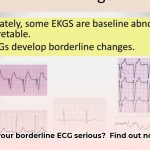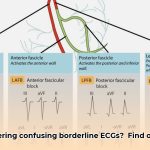A borderline ECG result might sound alarming, but it’s usually not a cause for immediate panic. Think of it as a signal that says, “Let’s take a closer look.” It often points to minor glitches in your heart’s electrical system, rather than a serious heart condition. However, following up on a borderline ECG is incredibly important to understand what’s going on and make sure everything’s alright. For more information on next steps, see this helpful guide on borderline ECG results.
Interpreting Borderline ECG Results and Next Steps
A borderline electrocardiogram (ECG) is not necessarily a definitive diagnosis of heart disease but a signal that the electrical activity of your heart shows readings slightly outside the typical range. Several factors can influence ECG results, including lifestyle choices; a thorough evaluation is vital. Here are some points to consider:
- A borderline ECG requires further investigation to determine the underlying cause.
- The interpretation is heavily dependent on individual factors such as age, medical history, and symptoms.
- Lifestyle modifications, like diet and exercise, can significantly impact heart health and sometimes improve ECG readings.
Understanding Borderline ECG Results
So, you received a borderline ECG. What does that even mean? Essentially, your electrocardiogram showed some readings slightly outside the typical range, but not definitively indicating a serious heart problem. Think of it like this: your car’s check engine light is on, but it’s not screaming at you – it’s a gentle warning prompting investigation. This doesn’t necessarily mean something is seriously wrong, but it does mean we need to explore further. The interpretation depends heavily on context – your age, medical history, symptoms, and overall health will all play a part in determining the next steps. Understanding how to interpret borderline ECG results and next steps requires a holistic approach, considering all these factors.
What Happens Next? Your Personalized Follow-Up Plan
Your doctor will guide you in navigating this, ensuring you receive appropriate care. Here’s what you can expect:
Step 1: Discuss the Results: Schedule an appointment to discuss your results with your cardiologist or primary care physician. They’ll review your ECG with you clearly, explaining the specific borderline findings. They’ll also consider your medical history and any symptoms you may have, such as chest pain, palpitations, or shortness of breath.
Step 2: Further Testing (if necessary): Depending on your individual situation, your doctor may recommend additional tests to gain a more comprehensive understanding of your heart’s function. The decision for further testing is based on your symptoms, risk factors, and the degree of deviation from a normal ECG.
-
Echocardiogram: This uses ultrasound to create moving pictures of your heart, helping to assess for structural abnormalities, valve function, and the heart’s pumping strength. It can detect conditions like enlarged heart, valve stenosis or regurgitation, and cardiomyopathy.
-
Stress Test: This evaluates heart function during physical exertion, checking for any issues that might only appear under stress, such as coronary artery disease or arrhythmias triggered by exercise. There are different types of stress tests, including treadmill exercise, pharmacological stress tests (using medication to mimic exercise), and stress echocardiograms.
-
Holter Monitor: This is a portable ECG that you wear for 24 hours or longer, even up to 30 days in some cases. It records your heart rhythm continuously to identify intermittent abnormalities that might not be captured during a standard ECG, such as atrial fibrillation, premature ventricular contractions (PVCs), or pauses in heart rhythm.
-
Event Monitor: Similar to a Holter monitor, but designed to be worn for even longer periods (weeks to months). It only records when you trigger it, typically when you feel symptoms.
-
Blood Tests: These may be ordered to check for electrolyte imbalances (such as potassium, magnesium, and calcium), thyroid function, or markers of heart damage (such as troponin or BNP). Electrolyte imbalances can influence your heart’s electrical activity, while thyroid abnormalities and elevated cardiac markers can indicate underlying heart conditions.
Step 3: Understanding the Outcomes: Following these tests, your doctor will provide a clearer picture of your heart health. The outcome might be a reassuring confirmation that everything is fine, or it could lead to a diagnosis and treatment plan for a more specific cardiac issue. Treatment options can include lifestyle changes, medications, or, in some cases, procedures like angioplasty or surgery.
Lifestyle Considerations
Your lifestyle significantly affects your heart health, including your electrocardiogram results. Implementing even small changes can make a big difference. These include:
-
Diet: Eating a balanced diet rich in fruits, vegetables, whole grains, and lean proteins is essential for maintaining heart health. Limit processed foods, sugary drinks, and unhealthy fats, which can contribute to heart disease. Consider following a heart-healthy diet like the Mediterranean diet or the DASH diet.
-
Exercise: Regular physical activity strengthens your heart and improves overall well-being, positively impacting ECG readings. Aim for at least 150 minutes of moderate-intensity or 75 minutes of vigorous-intensity aerobic exercise per week, along with strength training exercises at least two days per week.
-
Stress Management: Chronic stress can negatively impact your cardiac rhythm. Incorporate stress-reduction techniques into your daily routine. Consider meditation, yoga, deep breathing exercises, spending time in nature, or engaging in hobbies you enjoy. Cognitive Behavioral Therapy (CBT) can also be a helpful tool for managing stress.
-
Sleep: Aim for 7-9 hours of quality sleep each night. Poor sleep can contribute to high blood pressure and other cardiovascular problems.
-
Smoking Cessation: If you smoke, quitting is one of the best things you can do for your heart health. Smoking damages blood vessels and increases the risk of heart attack and stroke. Talk to your doctor about resources and support for quitting smoking.
Questions to Ask Your Doctor
Be prepared to ask questions! This will help you understand your situation completely. Here are some examples:
- What specifically caused my borderline ECG reading? What specific wave or interval abnormalities were noted?
- What are the potential risks associated with my findings? What are the chances of developing a more serious heart condition in the future?
- Why are you recommending this specific set of tests? What information will each test provide?
- What are the possible outcomes of these tests? What are the chances of a normal vs. abnormal result?
- What lifestyle changes could improve my heart health? What specific dietary changes, exercise recommendations, or stress management techniques do you recommend?
- Are there any medications I should be taking or avoiding?
- How often should I have follow-up checkups and ECGs?
Managing Borderline ECG Findings in Elderly Patients
It’s essential to manage borderline ECG findings, especially in elderly patients, because age-related changes in the heart can influence readings and may mask underlying conditions or, conversely, lead to unnecessary concern. A personalized approach and thorough evaluation are key to determining the appropriate course of action.
- A borderline ECG isn’t necessarily a cause for panic, but it needs further evaluation to rule out underlying issues.
- Interpretation depends heavily on individual factors, making a personalized approach crucial, especially in older adults. Factors like declining kidney function and medication interactions become more prominent with age.
- Follow-up often involves additional tests to clarify the findings and determine the best management strategy.
Understanding Borderline ECG Results
An electrocardiogram (ECG) measures your heart’s electrical activity. A “borderline” ECG shows subtle deviations from the norm but doesn’t clearly indicate a specific heart problem. Think of it like a slightly blurry photograph—you can see the main features, but some details are unclear. This is particularly important in managing borderline ECG findings in elderly patients, as age-related changes can sometimes mimic disease or make interpretation more complex. Examples of such changes include left ventricular hypertrophy (thickening of the heart muscle), atrial fibrillation (irregular heartbeat), and conduction abnormalities (slowing of electrical signals). Does this mean you have a serious heart condition? Not necessarily. It simply means further investigation is needed to rule out anything concerning.
What Happens Next? Your Follow-Up Plan
Your doctor will discuss the borderline ECG results with you, considering your age, overall health, family history, and symptoms (or lack thereof) before deciding on next steps. What might that involve? They will also consider factors specific to older adults, such as co-existing medical conditions (e.g., diabetes, kidney disease), medication use, and functional status.
-
Discussion with your Physician: This is the first and most crucial step. Your doctor will explain what the borderline findings mean in your specific context. They’ll answer your questions, address any concerns, and outline the recommended course of action. Be sure to bring a list of all your medications, including over-the-counter drugs and supplements.
-
Further Diagnostic Testing: Depending on the specific findings and your overall health, your doctor might order additional tests. These could include:
-
Echocardiogram: An ultrasound of your heart to assess its structure and function. It’s painless and provides detailed images to assess for valve problems, heart muscle weakness, or other structural abnormalities.
-
Stress Test: This assesses your heart’s response to exertion. It helps determine if your heart function is compromised under stress. If you have difficulty exercising, your doctor might recommend a pharmacological stress test, which uses medication to simulate the effects of exercise on your heart.
-
Holter Monitor: A portable
-
- Wellness Fair Ideas for Work to Boost Employee Wellbeing - December 15, 2025
- Affordable Employee Wellness Fair Ideas for Any Budget - December 14, 2025
- Employee Wellness Programs Strategically Benefit Employee Health And Retention - December 13, 2025
















